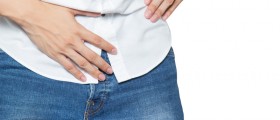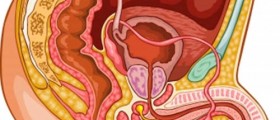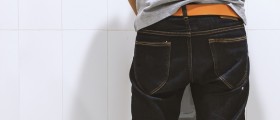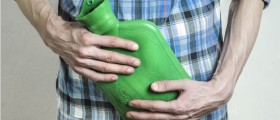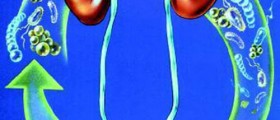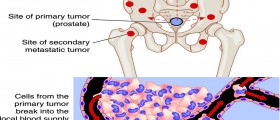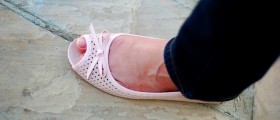Loading...
I like Buster, do not recall this happening to me, but others here have reported it also if I recall. I'd just keep an eye on It, if it doesn't go away in a reasonable amount of time, or gets worse, talk to your doc but otherwise it sounds like you're on track.. Slow steady improvement: more week to week or even month to month than day to day. Hang on there!
Loading...
Six months report
My (I am 73) surgery took place on JAN. 31, 2018 at IU Methodist. The surgeon was Dr. Amy Krambeck and assisting was Dr. Robert Orr. My prostate was 214 grams and they removed 100 grams according to the operative report. The surgery was scheduled for 2.5 to 3 hours but my surgery lasted 1 hour. I stayed overnight with a two way catheter (not comfortable) in me. One tube had fluid flushing my bladder and the other tube was draining my bladder.
After I urinated a couple of times I was pronounced good to go. The hospital provided me with a pad that wrapped front to back and was held in place by a fish net “brief.” Even the nurse apologized for the contraption. I really wish that I had brought my own underwear. I left the hospital around 11 am and I was home by 1pm. That day I had NO bladder control. I wet my pants 3 times. For the next two weeks I used diapers with a pad to hold everything. By the end of the first 2 weeks the bleeding had stopped.
During February and March I had urgency incontinence and it felt like my prostate had electrical charges running through it. I assume that feeling is the nerves that are healing. During that time i did my Kegel exercises. At the first of March I returned to the gym. April, May, June and July have been a slow progression toward healing.
I am now 6 months post surgery. I am down to one shield a day and I use nothing during the night. I generally do not have stress incontinence with the exception of some parts of my gym routine and occasionally when I am doing yard work. Oh well my shield takes care of it. I hope I will be fully continent soon. I do do my Kegel exercises daily.
I did test my tolerance for iced tea. I am not ready for a large amount. I drank a 32 ounce sweet tea and almost immediately I had leaking where I had none prior to drinking it. Guess I need to be cautious about the beverage irritants.
I was never prepared for incontinence by my local urologist or the surgeon’s office. Here are a couple of things. There are two name brands that make products for men; Tena and Depends. Each one ***this post is edited by moderator *** *** posting of web addresses is not allowed*** Please read our Terms of Use has a section for men. The most difficult thing for me has been the rash (crotch rot). I have tried a number of products but I am not totally satisfied with any of them. Right now I am using Aquaphor healing ointment, baby. It is for diaper rash and it works best for me. I also use Dr. Smith’s adult barrier spray.
I hope this helps those that are starting out on this road. There is light at the end of the tunnel!
Loading...
Has anyone had HoLEP by Dr. DiBlasio from Long Island, New York?
Would appreciate if u could share ur experience.
Loading...
U mentioned "Dr Akhil Das ..... has literally done thousands of HoLEPs." As u know, HoLEP is a difficult operation. Its success critically depends on the experience of the surgeon. So hope u don't mind me Asking from where did u obtained this info.
I am also looking for an urologist who is very experienced in HoLEP.
I am considering Dr. DiBlasio (a name I got from this forum) from Long Island, NY. The positive aspect about him is that he is a proctor or instructor who trains other doctors to do HoLEP, and the not so positive aspect is that he did his medical school in na offshore medical school, but I am not sure that is important at all. I was reading this column and came across ur very positive remark about Dr Das. If both Drs DiBlasio and Das have more than sufficient experience to do an successful HoLEP, I would prefer to go to Das. The reason is I live in NJ, going into New York is a big hassle, traffic, tolls and parking are headache.
If u could share more of ur experience about Dr. Das, I would greatly appreciate it. For example, how did u find out about him? Was there no other drs who offered HoLEP near DC? Was he responsive after the surgery, etc? Also , do u know others who have positive HoLEP opinion about dr Das.
Loading...
Education & Fellowships
Hahnemann University School of Medicine, Medical School
Residency: Thomas Jefferson University Hospital
Fellowship: Tauranga Hospital
Loading...
Indeed, Dr. Das had worked with Peter GIlling, one of the pioneers who developed HoLEP -- the laser, the enucleation technique and the morcellator.
I did a Google search on Peter GIlling Das, and it came up with:
"Holmium Laser Enucleation of the Prostate (HoLEP) Combined with Transurethral Tissue Morcellation: An Update on the Early Clinical Experience
PETER J. GILLING, KATIE KENNETT, AKHIL K. DAS, DAVID THOMPSON,2 MARK R. FRAUNDORFER
Published in 1998.
And
I also checked publications of Dr Das, he published papers with GIlling from 1998, 1999, 2001 and 2012.
See also
Canadian Journal of Urology
Volume 19, Issue 1, 2012, Pages 6131-6134
Holmium laser enucleation of the prostate technique for benign prostatic hyperplasia(Article)
Kelly, D.C., Das, A.
Department of Urology, Thomas Jefferson University Hospital, Philadelphia, PA, United States
He also seemed o be active in Holium laser research at Jefferson after he came back to the US. Based on this, I am of the opinion that Dr. Das has as much experience as dr. Lindeman from Indiana or the Mayo Clinic, both are highly recommended by some patients who had HoLEP in this column.
Dr. Das is such an expert on HoLEP really surprised me. If I hadn't read Bayneb's post and saw his strong recommendation and then checked on Dr. Das, I would not have known he had participated in the early development of HoLEP.
So we have someone so competent in HoLAP in the east coast, and we didn't even know about him and keep thinking should I go to Indiana to have HoLEP done there or go t Mayo.
Loading...
Hi DL0808, sorry for my delay in replying. If you were to go back through all the conversations in this forum (back to page one as I did), you'll see numerous conversations about the experience of both Dr Lingeman and Dr Das. My understanding is that they both went to New Zealand in the late 90s/early 2000s I believe and studied the technique and both brought it back here to the US at roughly the same time. They have both executed the procedure from then on, hence the vast experience they both have (as well as training numerous other urologists in the technique). As Dr Das explained to me, since he works with Jefferson Hospital (a teaching hospital) they are one the of few places that offer it since it is not altogether that profitable for hospitals due to the expense of the equipment, and the steep learning curve for the surgeon. Dr Das was also recommended to me by my local urologist here in Northern VA when I told him I wanted HoLEP - he immediately told me Dr Das was the Dr I should go to. So that recommendation, along with the good experiences I saw on this forum of others with Dr Das, as well as his proximity to me in Philly, led me to him. After meeting him, I was 100% ready to go with him (and he did indeed tell me he has done the procedure thousands of times). He has an excellent, caring manner, and will patiently explain everything you need to know. Now are there others who may be as good? I am sure there are. Dr Lingeman and Dr Krambeck get numerous kudos on these pages, for example (as well as others). However I can only speak for myself and the great experience I had with Dr Das. In the end, you should of course go with whoever works best for your situation, but I can heartily recommend Dr Das. If you have any other question, please don't hesitate to ask. All the best to you and good luck!
Loading...
I would like to ask all HoLEP reciepients a question but I am not sure it belongs to this column. If not, please let me know.
Similar to everyone else, I too hace also thought HoLEP is the best procedure for BPH. But after reading the posts in this column now I am not so sure. Almost all the HoLEP recipients seem to be suffering form INCONTINENCE and to a lesser degree blood in urine. These problems didn't go away even after 3 months. They don't seem to be "transient" as reported in some scientific studies.
These problems alarmed me. I recalled reading about aquablation which has comparable functional outcomes as TURP (but I didn't consider it because long term data is not available.). So I re-read the scientific studies again. I found:
"How I do it: Aquablation of the prostate using the AquaBeam system" by
Catriona MacRae, MBBS, Peter Gilling, FRACS Department of Urology, Tauranga Hospital, Tauranga, New Zealand, published in Dec 2016.
In this paper reported:
"The first published human study using the AquaBeam system was a single center non-randomized trial from our institution.11 Fifteen patients underwent aquablation, ... running from January 2013 to February 2014, were aged 50-80 years ... Prostate size ranged from 27cc-85 cc ....
Functional results were encouraging, with a statistically signi cant improvement in International Prostate Symptom Scores (IPSS), maximum ow rate (Qmax), quality of life scores (QoL) and post void residual (PVR)......
In this study eight of the fifteen patients had at least one adverse event, ....Five patients required re-catheterization; three had hematuria not requiring any intervention, and three complained of dysuria. No patient experienced INCONTINENCE, retrograde ejaculation or erectile dysfunction as measured by the IIEF-15 questionnaire.
...........
The third phase I trial1 also involved nine patients aged 62-75 (mean 66.7 years) with a mean prostate size of 61 cc (30 cc-102 cc). ... An unspecified number of patients experienced mild dysuria, with no other complication seen at 3 months of follow up. Once again there was no INCONTINENCE, retrograde ejaculation or erectile dysfunction reported.
In our experience, adverse events within the first 30 days postoperatively have been minor. Dysuria, hematuria, urinary tract infection, bladder spasm and metal stenosis have been seen, each affecting a single patient."
Peter GIlling was one of the inventors of HoLEP, published several high impact papers on HoLEP. His words carry a lot of weight.
So my questions to readers who had HoLEP is if u knew HoLEP would give u incontinence and hemasuria which last many months, and that aquablation would not, would u still go for HoLEP?
Loading...
If you haven't seen it, I recommend reading this thorough article on aquablation. Here is the link:
http://journals.sagepub.com/doi/full/10.1177/1756287218760518
Based on the article, it appears that many sufferers of BPH would not be judged eligible for aquablation: those with very enlarged prostates (greater than 100ml), and those with urinary retention. These conditions are no bar to Holep. So I assume if you're considering aquablation, you believe you would not be judged ineligible? Based on the article, I would not have been eligible since I had urinary retention and my enlarged prostate was borderline ineligible. I suspect many of us who have had Holep would have failed the eligibility criteria for aquablation.
It is true that early results of aquablation are promising, but you should weigh the fact that there have not yet been extensive numbers of men who have had the procedure. If you choose to go that route, you are, to some extent, taking a risk since the procedure is still fairly new.
I believe most men who have undergone Holep have blood in their urine only for a few days or maybe a week or so. That was true for me. The biggest weakness of Holep, I believe, is indeed incontinence, though how long it lasts does vary quite a bit from one man to another. From my understanding, on average incontinence can last up to about three months, but it does typically decrease during that period.
While retrograde ejaculation apparently occurs in all men post-Holep, sexual function and sexual enjoyment does return fairly quickly for most men. So I don't see that as a major problem.
I would say your decision depends partly on how soon you feel you need to have a procedure to improve your situation. Can you wait a year until there is more information on how well aquablation works? If not, are you willing to risk a new procedure that is promising but not yet fully tested?
If it were me, to answer your question, I would go with Holep, which I did, and do not regret.
Loading...
Loading...
Loading...
In aquablation, those tissues which are responsible for normal ejaculation are programmed not to be cut, thus the RE rate is about 10-20% (this technique is known as Ejaculation Preservation or Hood Sparing), whereas the RE rate for HoLEP is 80-90% (or a normal ejaculation rate of 10-20%).
EP is probably considered to be more important by a majority of BPH sufferers than incontinance if the latter indeed is transient.
The current situation for me (a BPH sufferers) is: I need surgical intervention, and there are TURP, HoLEP, Green Laser, Urolift, Rezum, PAE, Etc. For me, I opt for a more durable, more sure solution. So I eliminated Urolift, PAE, Rezum. I am left with TURP, GLL and HoLEP. I could not convince any GLL urologist to use ejaculation preservation (spare those tissues which is within 1CM of the verumontanum). So I thought if I am going to get RE, may as well pick the best technology, HoLEP.
Then I learned there is something new, not a gimmick. Sure there is no long term data, but it has been five years since it was used to treat patients and is backed by two well known, well regarded Urologists, Peter GIlling and Roehrborn. Data from Scientific studies showed that aquablation and TURP have about the same functional outcomes, but aqua does not make me incontinence and there is an 89-90% chance I will have normal ejaculation, this really make me hesitate to go for HoLEP right away.
If aquablation is indeed has less complications than HoLEP, then we have a new situation: HoLEP is slightly better than aquablation in functional outcomes, but aquablation will not have incontinence and there is a 80-90% chance of having normal ejaculation, which one will u pick? Urolift is 100%, but the functional outcomes is a larger gap below HoLEP.
Loading...
first, because we have already made the decision. Second, because it's really a very personal decision depending on what is most important to you. I get the impression that normal ejaculation is very important to you. For me, it wasn't. I was 79 in December 2016 when I had the Holep and no longer sexually active, so the retrograde ejaculation was of no importance to me. I don't know how old you are but I'm guessing you're younger than me.
Loading...
All the best to you on your decision.
Loading...



